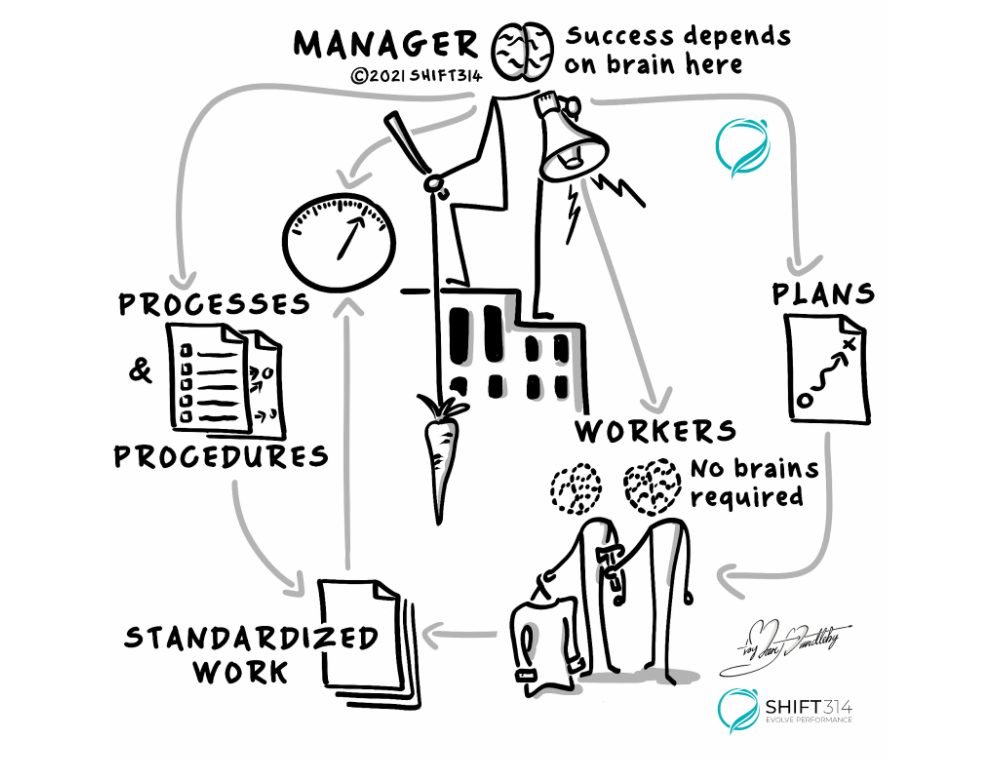If you are doing anything that remotely resembles traditional management, then chances are that there is a huge opportunity to move to a more effective way of managing people.
Traditional management is a practice that was started around 1900. We could call it “business as usual.” It’s built on this basic notion that the best way to govern an organization effectively is to have a hierarchy. This hierarchy is designed to make sure that people – the workers at the very bottom – do what they’re told.

When Workers Have No Brains
Traditional Management may be very familiar to you – it may be the only way you know how to conduct business. This is traditional management: managers create strategic objectives to let the people know exactly what they need to be working on. Managers then have reports to measure and understand the work that is coming out of people and to know where to focus, who needs help, where to put attention, who’s not doing their job, and who to blame when things go wrong.

The idea feels something like this: “We’re going to standardize everything because we want to be able to make sure everyone knows how to get it done.” Structure and policy is needed. People are treated as replaceable, commodity parts. This outdated paradigm, originally created for industrial management, is what is believed to give us high performance.” That’s the mindset.
The basis of traditional management is a very strange assumption: Workers have no brains. The managers have to tell the workers what to do. Of course, this implies that managers have all the brains. They have to command and control workers and motivate them with a carrot and a stick. They create plans to guide them.
When we start from this premise, we have to ask ourselves, “How is it that we are still using the same management techniques from over 100 years ago?” Or perhaps “How do we get high performance if we do not use this style of management?”
Traditional Management and Employee Disengagement
The consequence of the traditional management mindset is that workers feel like they have no brains. Traditional management has led to the epidemic levels of employee disengagement that we see around the globe. It even leads to disengagement with middle managers because they themselves only have “half a brain”. They have very limited decision-making power and authority.

It’s also toxic for CEOs: they see all the damage and harm that’s being done, but they don’t know a better way to function. Even though they have this feeling that something’s not quite right eating away at them, they don’t have a way of operating differently.
When Things Go Wrong: Doubling Down
Usually when something goes wrong in a traditionally managed organization, people double down on processes, reports, command-and-control, and directing. They don’t stop to ask “Hey, the system is not working. Can we look at a different way of doing things?” Instead, they get more involved and begin micromanaging. All of this arises from an attachment to a traditional way of functioning that, at its core, just doesn’t work.
A Better Way Forward: Evolutionary Leadership
There is a fundamental shift needed for managers to create an environment where people are inspired and motivated. It’s this shift that will create an environment where healthy choices can be made to unlock the high performance of the organization. The shift is simple: evolving from a management mindset to an Evolutionary Leadership mindset. Here are the fundamentals of what that looks like.

1. Recognizing Performance Comes from People
When we move to an Evolutionary Leadership mindset, we realize that performance comes from people, and that people are the most important assets of the organizational system. While elements like customer focus are helpful, highly successful customer outcomes only come from highly successful employee outcomes. As we move toward Evolutionary Leadership, we start to understand that our job as managers is to lead the people in the organization to a better way of functioning.
2. Leading Others, Leading Yourself
Before you can lead anybody else, you need to learn how to lead yourself. What does leading yourself mean? It means taking full accountability for your behavior and any destructive command-and-control tendencies. It’s also about taking full responsibility for your emotional state and reactions, and your own growth, learning, and evolution.
What happens to leaders who start to take responsibility and have the tools to evolve beyond limiting behaviors and emotional reactions? They are much more able to walk the talk, lead by example. They can set the tone of the organization through how they show up in meetings and respond to email. When leaders are able to do that, they are able to invite other people to show up in a similar way.

It’s not about telling people to show up differently. It’s about leaders who really work on their own self-evolution and self-leadership. Through this approach they are able to inspire others to show up as their best selves. They’re able to be open enough to support other people’s evolution and growth. When we as leaders develop our own leadership, we’re much more able to help others develop theirs.
3. New Work Practices
For many decades, whether through Lean, Digital, or Agile, new ways to run our organizational systems have been established. As leaders, our learning journey requires that we learn how to support these new ways of working. It’s not just learning how they function. It’s about how to create an environment where they can flourish. It’s vital to learn the practical, external world of skills, patterns, and interactions to support the evolution of our organizational system.
4. New Ways of Being
New ways of working depend on new ways of being. A shift toward a higher level of functioning requires a shift in the consciousness or mindset of all the people in the organization. As leaders, it’s incumbent upon us to lead this shift of consciousness to be that calm, stable presence. When we are humble and curious to manifest the qualities of a more evolved leader.

To the extent that we manifest these attributes of Evolutionary Leadership, our ability to unlock new ways of working and to invite other people to evolve themselves will increase. Our own shift toward a more evolved way of being as a leader is essential to unlock the change we hope for. Only then can we move beyond traditional management.
Final Thoughts
Management is a role that we have. Evolutionary Leadership is a choice that we make. It’s the choice to show up in ways that are inviting for other people to follow us. To inspire others to create a better future for ourselves and our organizational system together. To evolve as a leader or not to evolve as leader, that is the question.



